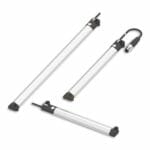(30th September 2019, Arvada, CO, USA) Nanometer management of motion is becoming more and more common across industry as technology solutions work to tighter and tighter tolerances. This trend is prevalent in numerous positioning sensitive industries, such as fiber optics, biomedical, micro machines, electronics, semiconductors, energy, optics, aerospace, and synchrotrons.
ALIO Industries is the world leader in the provision of nano-precision vacuum stage and robotic systems. The company’s extensive range of ultra-precise and repeatable motion control solutions (with exception of its air bearing systems) are vacuum compatible. Linear, rotary, open center X-Y, hexapods, tripods and goniometer stages and systems are available in HV (10-7 TORR) or UHV (10-10 TORR) with ultra low outgassing materials and components all carefully prepared and baked.
Nano-positioning applications are exacting and are further complicated when the management of motion is under vacuum, or when the requirement is for extended travel, finer repeatability, higher speed, greater uptime and — of course — lower cost. Drive mechanisms, bearings, feedback systems, motion controllers, and the kinematic structure all need to be designed to perfection to meet nanometer precision in atmospheric or vacuum environments.
Material Selection. The first design decision when creating a nanometer-level vacuum motion system is the material used for the bearings and structure. Vacuum motion systems are typically made from bare 6061 aluminium or 300 or 400 series stainless steel. Since most precision bearings in vacuum are made from 400 stainless steel, the use of 300 or 400 stainless steel for the motion system is recommended when thermal variations are a feature of the application or experiment. This allows for the bearings and structure to deviate at the same rate, which means the bearings can maintain preload.
Precision Bearings. Mechanical bearings suitable for vacuum applications range from recirculating ball rail, linear ball bearings, ceramic linear ball bearings, and crossed roller bearings. To consistently meet nanometer-level precision, ALIO advocates the use of crossed roller bearings. It is important to use the highest-grade bearings to assure precision. The better quality bearings have rollers matched in size allowing for smoother motion, less friction, and less straightness deviation along the path.
Position Feedback. Position feedback systems in a vacuum chamber have special designs to ensure performance and no outgassing. ALIO uses optical encoders that read either to a tape or glass scale, or when more precision is required read to a scale etched directly into a stainless steel of a ring (for rotary applications), or onto a nickel plated invar spar (for linear applications) The invar scale allows for near laser precision with repeatability and accuracy as it is calibrated using an interferometer. Placing the scale on invar greatly reduces thermal effect that influences the accuracy of other scales. ALIO also uses a laser interferometer to provide resolutions to 38 picometers providing positioning stability — on a suitable mechanical system — to sub-nanometer levels.
Drive Mechanism. For vacuum motion control applications, ALIO uses piezoelectric driven stages and linear and rotary servo motors. Ceramic servo motors are unique in their motion acting as a spiralling friction motor, which allows for unlimited travel without mechanical hysteresis while maintaining nanometer precision. Servo motors are much more robust with higher forces and higher duty cycles but are currently limited to 10-7 Both drive motors have no drive inertia and no hysteresis. These piezo motors stages are well suited for ultra high vacuum environments (10-10 TORR) due to the material’s limited outgassing.
Lubrication. ALIO uses a range of wet to dry vacuum compatible lubricants. The most commonly used is Krytox, which is used with mechanical bearings and screw systems. This viscous lubricant works well, but it must be applied carefully otherwise it will cause bearings to skid and stick. ALIO uses various formulas of Krytox depending on the application and customer preference. The uses of dry lubricants in the form of thin films are easy to apply and offer low friction and smooth motion. There are many dry lubricants available for UHV but ALIO has had great success with two types — Molybdenum Disulfide and Tungsten Disulfide.
Kinematic Structure. Serial kinematics work well for single, two, three, or four axis systems, but the design and machining of these axes is critical when reducing errors such as sine / cosine and orthogonality when stacked, and must address the potential for thermal deviations caused by the motor, and stacking the axis in a manner that increases motion forces. When extreme precision is needed for five and more axes, the parallel kinematic solution is the best choice. With parallel kinematic solutions the error quotient is not additive thus reducing the concern for serial kinematic sine / cosine and orthogonality error quotient. Parallel kinematics typically take up less valuable space in a chamber versus serial kinematics. Hexapods with forward and inverse kinematics have velocity and path motion that can enhance motion profiles that serial kinematics may not be able to handle due to sub-micron errors associated with the stacking of stages.
Motion systems for nanometer precision have many critical components that must work well together for nanometer precision and when you place these components in a UHV chamber these components need to be carefully re-engineered to assure heat dissipation, outgassing, and precision motion.
ALIO invites any companies interested in a nanometer-level motion control solution for vacuum applications to contact the company and engage with experts that can work towards a customized and cost-sensitive system.







